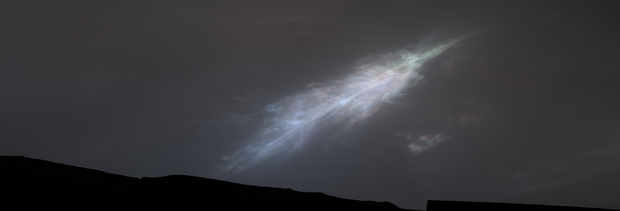NASA's Curiosity rover spots "sun rays" on Mars for the first time
NASA's Curiosity rover has captured "sun rays" on Mars for the first time, the agency says.
The footage was taken on Feb. 6, NASA said, and showed the phenomenon as the sun set on the planet. This is the first time, NASA said, that the sun rays, also known as crepuscular rays, have been viewed so clearly.
NASA shared a glimpse at what the rover had captured on their Twitter account. The photo shows a grey sky over a rocky black landscape, with patches of red and green light visible.
Martian sunsets are moody.
— NASA JPL (@NASAJPL) March 6, 2023
However, last month @MarsCuriosity captured a different kind of sunset on the planet. Rays of light illuminated a bank of clouds, making it the first time sun rays have been so clearly viewed on Mars: https://t.co/HhKa0IAWWv pic.twitter.com/iToToqaQmb
The moment was captured as the rover conducted a twilight cloud survey, building on previous observations of clouds. Previously recorded images of Martian clouds show them as being made of water ice and hovering no more 37 miles above Mars' surface. The new images captured by Curiosity appears to show clouds at a "higher altitude, where it's especially cold," NASA said, suggesting that the clouds are made of carbon dioxide ice, or dry ice.
Another photo, NASA said, shows a "feather-shaped iridescent cloud." That image, taken just after sunset on Jan. 27, helps provide scientists with information about the particle sizes within the clouds.
Both photos, NASA said, were captured as panoramas, "each of which was stitched together from 28 images sent to Earth." The images "have been processed to emphasize the highlights," the agency said.

Curiosity's previous cloud survey, conducted in 2021, used black-and-white navigation cameras to get a detailed look at the structure of moving clouds, but the more recent survey, which began in January, uses the rover's color camera to see how cloud particles grow over time, NASA said. The current survey will end in mid-March.
"As on Earth, clouds provide scientists with complex but crucial information for understanding the weather. By looking at when and where clouds form, scientists can learn more about the Martian atmosphere's composition and temperatures, and the winds within it," NASA said.
Curiosity was launched in 2011 and landed on Mars in August 2012. According to NASA, the rover's primary mission is to determine if Mars can support small life forms known as microbes. In the past, Curiosity has found evidence of past habitable environments on Mars, and it has found carbon, a "key life ingredient" on the planet.
- In:
- Mars Rover
- Mars
- Space

Kerry Breen is a news editor and reporter for CBS News. Her reporting focuses on current events, breaking news and substance use.
Disclaimer: The copyright of this article belongs to the original author. Reposting this article is solely for the purpose of information dissemination and does not constitute any investment advice. If there is any infringement, please contact us immediately. We will make corrections or deletions as necessary. Thank you.







